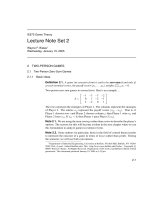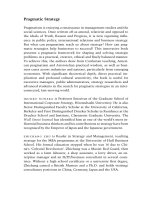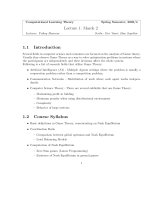Algorithmic game theory
Bạn đang xem bản rút gọn của tài liệu. Xem và tải ngay bản đầy đủ của tài liệu tại đây (5.17 MB, 775 trang )
Algorithmic Game Theory
Over the last few years, there has been explosive growth in the research done at the interface of computer science, game theory, and economic theory, largely motivated by the
emergence of the Internet. Algorithmic Game Theory develops the central ideas and results
of this new and exciting area.
More than 40 of the top researchers in this field have written chapters whose topics
range from the foundations to the state of the art. This book contains an extensive treatment
of algorithms for equilibria in games and markets, computational auctions and mechanism
design, and the “price of anarchy,” as well as applications in networks, peer-to-peer systems,
security, information markets, and more.
This book will be of interest to students, researchers, and practitioners in theoretical
computer science, economics, networking, artificial intelligence, operations research, and
discrete mathematics.
Noam Nisan is a Professor in the Department of Computer Science at The Hebrew University of Jerusalem. His other books include Communication Complexity.
Tim Roughgarden is an Assistant Professor in the Department of Computer Science at
Stanford University. His other books include Selfish Routing and the Price of Anarchy.
´ Tardos is a Professor in the Department of Computer Science at Cornell University.
Eva
Her other books include Algorithm Design.
Vijay V. Vazirani is a Professor in the College of Computing at the Georgia Institute of
Technology. His other books include Approximation Algorithms.
Algorithmic Game Theory
Edited by
Noam Nisan
Hebrew University of Jerusalem
Tim Roughgarden
Stanford University
´ Tardos
Eva
Cornell University
Vijay V. Vazirani
Georgia Institute of Technology
cambridge university press
Cambridge, New York, Melbourne, Madrid, Cape Town, Singapore, S˜ao Paulo, Delhi
Cambridge University Press
32 Avenue of the Americas, New York, NY 10013-2473, USA
www.cambridge.org
Information on this title: www.cambridge.org/9780521872829
C
´ Tardos, Vijay V. Vazirani 2007
Noam Nisan, Tim Roughgarden, Eva
This publication is in copyright. Subject to statutory exception
and to the provisions of relevant collective licensing agreements,
no reproduction of any part may take place without
the written permission of Cambridge University Press.
First published 2007
Printed in the United States of America
A catalog record for this book is available from the British Library.
Library of Congress Cataloging in Publication Data
Algorithmic game theory / edited by Noam Nisan . . . [et al.]; foreword
by Christos Papadimitriou.
p. cm.
Includes index.
ISBN-13: 978-0-521-87282-9 (hardback)
ISBN-10: 0-521-87282-0 (hardback)
1. Game theory. 2. Algorithms. I. Nisan, Noam. II. Title.
QA269.A43 2007
519.3–dc22
2007014231
ISBN 978-0-521-87282-9 hardback
Cambridge University Press has no responsibility for
the persistence or accuracy of URLS for external or
third-party Internet Web sites referred to in this publication
and does not guarantee that any content on such
Web sites is, or will remain, accurate or appropriate.
Contents
page xiii
xvii
xix
Foreword
Preface
Contributors
I Computing in Games
1 Basic Solution Concepts and Computational Issues
´ Tardos and Vijay V. Vazirani
Eva
1.1 Games, Old and New
1.2 Games, Strategies, Costs, and Payoffs
1.3 Basic Solution Concepts
1.4 Finding Equilibria and Learning in Games
1.5 Refinement of Nash: Games with Turns and Subgame Perfect Equilibrium
1.6 Nash Equilibrium without Full Information: Bayesian Games
1.7 Cooperative Games
1.8 Markets and Their Algorithmic Issues
Acknowledgments
Bibliography
Exercises
2 The Complexity of Finding Nash Equilibria
Christos H. Papadimitriou
2.1 Introduction
2.2 Is the Nash Equilibrium Problem NP-Complete?
2.3 The Lemke–Howson Algorithm
2.4 The Class PPAD
2.5 Succinct Representations of Games
2.6 The Reduction
2.7 Correlated Equilibria
2.8 Concluding Remarks
Acknowledgment
Bibliography
v
3
3
9
10
16
18
20
20
22
26
26
26
29
29
31
33
36
39
41
45
49
50
50
vi
contents
3 Equilibrium Computation for Two-Player Games in Strategic
and Extensive Form
Bernhard von Stengel
3.1 Introduction
3.2 Bimatrix Games and the Best Response Condition
3.3 Equilibria via Labeled Polytopes
3.4 The Lemke–Howson Algorithm
3.5 Integer Pivoting
3.6 Degenerate Games
3.7 Extensive Games and Their Strategic Form
3.8 Subgame Perfect Equilibria
3.9 Reduced Strategic Form
3.10 The Sequence Form
3.11 Computing Equilibria with the Sequence Form
3.12 Further Reading
3.13 Discussion and Open Problems
Bibliography
Exercises
4 Learning, Regret Minimization, and Equilibria
Avrim Blum and Yishay Mansour
4.1 Introduction
4.2 Model and Preliminaries
4.3 External Regret Minimization
4.4 Regret Minimization and Game Theory
4.5 Generic Reduction from External to Swap Regret
4.6 The Partial Information Model
4.7 On Convergence of Regret-Minimizing Strategies to Nash
Equilibrium in Routing Games
4.8 Notes
Bibliography
Exercises
5 Combinatorial Algorithms for Market Equilibria
Vijay V. Vazirani
5.1 Introduction
5.2 Fisher’s Linear Case and the Eisenberg–Gale Convex Program
5.3 Checking If Given Prices Are Equilibrium Prices
5.4 Two Crucial Ingredients of the Algorithm
5.5 The Primal-Dual Schema in the Enhanced Setting
5.6 Tight Sets and the Invariant
5.7 Balanced Flows
5.8 The Main Algorithm
5.9 Finding Tight Sets
5.10 Running Time of the Algorithm
5.11 The Linear Case of the Arrow–Debreu Model
5.12 An Auction-Based Algorithm
5.13 Resource Allocation Markets
53
53
54
57
61
63
65
66
68
69
70
73
75
75
76
77
79
79
81
82
88
92
94
96
99
99
101
103
103
105
108
109
109
111
111
115
117
118
121
122
124
contents
5.14 Algorithm for Single-Source Multiple-Sink Markets
5.15 Discussion and Open Problems
Bibliography
Exercises
6 Computation of Market Equilibria by Convex Programming
Bruno Codenotti and Kasturi Varadarajan
6.1 Introduction
6.2 Fisher Model with Homogeneous Consumers
6.3 Exchange Economies Satisfying WGS
6.4 Specific Utility Functions
6.5 Limitations
6.6 Models with Production
6.7 Bibliographic Notes
Bibliography
Exercises
7 Graphical Games
Michael Kearns
7.1 Introduction
7.2 Preliminaries
7.3 Computing Nash Equilibria in Tree Graphical Games
7.4 Graphical Games and Correlated Equilibria
7.5 Graphical Exchange Economies
7.6 Open Problems and Future Research
7.7 Bibliographic Notes
Acknowledgments
Bibliography
8 Cryptography and Game Theory
Yevgeniy Dodis and Tal Rabin
8.1 Cryptographic Notions and Settings
8.2 Game Theory Notions and Settings
8.3 Contrasting MPC and Games
8.4 Cryptographic Influences on Game Theory
8.5 Game Theoretic Influences on Cryptography
8.6 Conclusions
8.7 Notes
Acknowledgments
Bibliography
vii
126
131
132
133
135
135
141
142
148
150
152
155
156
158
159
159
161
164
169
176
177
177
179
179
181
181
187
189
191
197
202
203
204
204
II Algorithmic Mechanism Design
9 Introduction to Mechanism Design (for Computer Scientists)
Noam Nisan
9.1 Introduction
9.2 Social Choice
9.3 Mechanisms with Money
9.4 Implementation in Dominant Strategies
209
209
211
216
222
viii
contents
9.5 Characterizations of Incentive Compatible Mechanisms
9.6 Bayesian–Nash Implementation
9.7 Further Models
9.8 Notes
Acknowledgments
Bibliography
10 Mechanism Design without Money
James Schummer and Rakesh V. Vohra
10.1 Introduction
10.2 Single-Peaked Preferences over Policies
10.3 House Allocation Problem
10.4 Stable Matchings
10.5 Future Directions
10.6 Notes and References
Bibliography
Exercises
11 Combinatorial Auctions
Liad Blumrosen and Noam Nisan
11.1 Introduction
11.2 The Single-Minded Case
11.3 Walrasian Equilibrium and the LP Relaxation
11.4 Bidding Languages
11.5 Iterative Auctions: The Query Model
11.6 Communication Complexity
11.7 Ascending Auctions
11.8 Bibliographic Notes
Acknowledgments
Bibliography
Exercises
12 Computationally Efficient Approximation Mechanisms
Ron Lavi
12.1 Introduction
12.2 Single-Dimensional Domains: Job Scheduling
12.3 Multidimensional Domains: Combinatorial Auctions
12.4 Impossibilities of Dominant Strategy Implementability
12.5 Alternative Solution Concepts
12.6 Bibliographic Notes
Bibliography
Exercises
13 Profit Maximization in Mechanism Design
Jason D. Hartline and Anna R. Karlin
13.1 Introduction
13.2 Bayesian Optimal Mechanism Design
13.3 Prior-Free Approximations to the Optimal Mechanism
13.4 Prior-Free Optimal Mechanism Design
225
233
238
239
240
241
243
243
244
253
255
262
263
264
264
267
267
270
275
279
283
287
289
295
296
296
298
301
301
303
310
317
321
327
327
328
331
331
335
339
344
contents
13.5 Frugality
13.6 Conclusions and Other Research Directions
13.7 Notes
Bibliography
Exercises
14 Distributed Algorithmic Mechanism Design
Joan Feigenbaum, Michael Schapira, and Scott Shenker
14.1 Introduction
14.2 Two Examples of DAMD
14.3 Interdomain Routing
14.4 Conclusion and Open Problems
14.5 Notes
Acknowledgments
Bibliography
Exercises
15 Cost Sharing
Kamal Jain and Mohammad Mahdian
15.1 Cooperative Games and Cost Sharing
15.2 Core of Cost-Sharing Games
15.3 Group-Strategyproof Mechanisms and Cross-Monotonic
Cost-Sharing Schemes
15.4 Cost Sharing via the Primal-Dual Schema
15.5 Limitations of Cross-Monotonic Cost-Sharing Schemes
15.6 The Shapley Value and the Nash Bargaining Solution
15.7 Conclusion
15.8 Notes
Acknowledgments
Bibliography
Exercises
16 Online Mechanisms
David C. Parkes
16.1 Introduction
16.2 Dynamic Environments and Online MD
16.3 Single-Valued Online Domains
16.4 Bayesian Implementation in Online Domains
16.5 Conclusions
16.6 Notes
Acknowledgments
Bibliography
Exercises
ix
350
354
357
358
360
363
363
366
370
379
380
381
381
383
385
385
387
391
394
400
402
405
406
408
408
410
411
411
413
417
431
435
436
437
437
439
III Quantifying the Inefficiency of Equilibria
17 Introduction to the Inefficiency of Equilibria
´ Tardos
Tim Roughgarden and Eva
17.1 Introduction
443
443
x
contents
17.2 Fundamental Network Examples
17.3 Inefficiency of Equilibria as a Design Metric
17.4 Notes
Bibliography
Exercises
446
454
456
457
459
18 Routing Games
Tim Roughgarden
18.1 Introduction
18.2 Models and Examples
18.3 Existence, Uniqueness, and Potential Functions
18.4 The Price of Anarchy of Selfish Routing
18.5 Reducing the Price of Anarchy
18.6 Notes
Bibliography
Exercises
461
19 Network Formation Games and the Potential Function Method
´ Tardos and Tom Wexler
Eva
19.1 Introduction
19.2 The Local Connection Game
19.3 Potential Games and a Global Connection Game
19.4 Facility Location
19.5 Notes
Acknowledgments
Bibliography
Exercises
20 Selfish Load Balancing
Berthold V¨ocking
20.1 Introduction
20.2 Pure Equilibria for Identical Machines
20.3 Pure Equilibria for Uniformly Related Machines
20.4 Mixed Equilibria on Identical Machines
20.5 Mixed Equilibria on Uniformly Related Machines
20.6 Summary and Discussion
20.7 Bibliographic Notes
Bibliography
Exercises
21 The Price of Anarchy and the Design of Scalable Resource
Allocation Mechanisms
Ramesh Johari
21.1 Introduction
21.2 The Proportional Allocation Mechanism
21.3 A Characterization Theorem
21.4 The Vickrey–Clarke–Groves Approach
21.5 Chapter Summary and Further Directions
461
462
468
472
478
480
483
484
487
487
489
494
502
506
511
511
513
517
517
522
524
529
533
537
538
540
542
543
543
544
551
559
564
contents
xi
565
566
567
21.6 Notes
Bibliography
Exercises
IV Additional Topics
22 Incentives and Pricing in Communications Networks
Asuman Ozdaglar and R. Srikant
22.1 Large Networks – Competitive Models
22.2 Pricing and Resource Allocation – Game Theoretic Models
22.3 Alternative Pricing and Incentive Approaches
Bibliography
571
572
578
587
590
23 Incentives in Peer-to-Peer Systems
Moshe Babaioff, John Chuang, and Michal Feldman
23.1 Introduction
23.2 The p2p File-Sharing Game
23.3 Reputation
23.4 A Barter-Based System: BitTorrent
23.5 Currency
23.6 Hidden Actions in p2p Systems
23.7 Conclusion
23.8 Bibliographic Notes
Bibliography
Exercises
593
24 Cascading Behavior in Networks: Algorithmic and Economic Issues
Jon Kleinberg
24.1 Introduction
24.2 A First Model: Networked Coordination Games
24.3 More General Models of Social Contagion
24.4 Finding Influential Sets of Nodes
24.5 Empirical Studies of Cascades in Online Data
24.6 Notes and Further Reading
Bibliography
Exercises
613
25 Incentives and Information Security
Ross Anderson, Tyler Moore, Shishir Nagaraja, and Andy Ozment
25.1 Introduction
25.2 Misaligned Incentives
25.3 Informational Asymmetries
25.4 The Economics of Censorship Resistance
25.5 Complex Networks and Topology
25.6 Conclusion
25.7 Notes
Bibliography
593
594
596
600
601
602
608
608
609
610
613
614
618
622
627
630
631
632
633
633
634
636
640
643
646
647
648
xii
contents
26 Computational Aspects of Prediction Markets
David M. Pennock and Rahul Sami
26.1 Introduction: What Is a Prediction Market?
26.2 Background
26.3 Combinatorial Prediction Markets
26.4 Automated Market Makers
26.5 Distributed Computation through Markets
26.6 Open Questions
26.7 Bibliographic Notes
Acknowledgments
Bibliography
Exercises
27 Manipulation-Resistant Reputation Systems
Eric Friedman, Paul Resnick, and Rahul Sami
27.1 Introduction: Why Are Reputation Systems Important?
27.2 The Effect of Reputations
27.3 Whitewashing
27.4 Eliciting Effort and Honest Feedback
27.5 Reputations Based on Transitive Trust
27.6 Conclusion and Extensions
27.7 Bibliographic Notes
Bibliography
Exercises
28 Sponsored Search Auctions
S´ebastien Lahaie, David M. Pennock, Amin Saberi, and Rakesh V. Vohra
28.1 Introduction
28.2 Existing Models and Mechanisms
28.3 A Static Model
28.4 Dynamic Aspects
28.5 Open Questions
28.6 Bibliographic Notes
Bibliography
Exercises
651
651
652
657
662
665
670
671
672
672
674
677
677
680
682
683
689
693
694
695
696
699
699
701
702
707
711
712
713
715
29 Computational Evolutionary Game Theory
Siddharth Suri
29.1 Evolutionary Game Theory
29.2 The Computational Complexity of Evolutionarily Stable Strategies
29.3 Evolutionary Dynamics Applied to Selfish Routing
29.4 Evolutionary Game Theory over Graphs
29.5 Future Work
29.6 Notes
Acknowledgments
Bibliography
Exercises
717
717
720
723
728
733
733
734
734
735
Index
737
Foreword
As the Second World War was coming to its end, John von Neumann, arguably the
foremost mathematician of that time, was busy initiating two intellectual currents that
would shape the rest of the twentieth century: game theory and algorithms. In 1944 (16
years after the minmax theorem) he published, with Oscar Morgenstern, his Games
and Economic Behavior, thus founding not only game theory but also utility theory and
microeconomics. Two years later he wrote his draft report on the EDVAC, inaugurating
the era of the digital computer and its software and its algorithms. Von Neumann wrote
in 1952 the first paper in which a polynomial algorithm was hailed as a meaningful
advance. And, he was the recipient, shortly before his early death four years later, of
G¨odel’s letter in which the P vs. NP question was first discussed.
Could von Neumann have anticipated that his twin creations would converge half
a century later? He was certainly far ahead of his contemporaries in his conception
of computation as something dynamic, ubiquitous, and enmeshed in society, almost
organic – witness his self-reproducing automata, his fault-tolerant network design, and
his prediction that computing technology will advance in lock-step with the economy
(for which he had already postulated exponential growth in his 1937 Vienna Colloquium
paper). But I doubt that von Neumann could have dreamed anything close to the Internet,
the ubiquitous and quintessentially organic computational artifact that emerged after
the end of the Cold War (a war, incidentally, of which von Neumann was an early
soldier and possible casualty, and that was, fortunately, fought mostly with game
theory and decided by technological superiority – essentially by algorithms – instead
of the thermonuclear devices that were von Neumann’s parting gift to humanity).
The Internet turned the tables on students of both markets and computation. It
transformed, informed, and accelerated markets, while creating new and theretofore
unimaginable kinds of markets – in addition to being itself, in important ways, a market.
Algorithms became the natural environment and default platform of strategic decision
making. On the other hand, the Internet was the first computational artifact that was not
created by a single entity (engineer, design team, or company), but emerged from the
strategic interaction of many. Computer scientists were for the first time faced with an
object that they had to feel with the same bewildered awe with which economists have
xiii
xiv
foreword
always approached the market. And, quite predictably, they turned to game theory for
inspiration – in the words of Scott Shenker, a pioneer of this way of thinking who has
contributed to this volume, “the Internet is an equilibrium, we just have to identify the
game.” A fascinating fusion of ideas from both fields – game theory and algorithms –
came into being and was used productively in the effort to illuminate the mysteries of
the Internet. It has come to be called algorithmic game theory.
The chapters of this book, a snapshot of algorithmic game theory at the approximate
age of ten written by a galaxy of its leading researchers, succeed brilliantly, I think, in
capturing the field’s excitement, breadth, accomplishment, and promise. The first few
chapters recount the ways in which the new field has come to grips with perhaps the
most fundamental cultural incongruity between algorithms and game theory: the latter
predicts the agents’ equilibrium behavior typically with no regard to the ways in which
such a state will be reached – a consideration that would be a computer scientist’s
foremost concern. Hence, algorithms for computing equilibria (Nash and correlated
equilibria in games, price equilibria for markets) have been one of algorithmic game
theory’s earliest research goals. This body of work has become a valuable contribution to the debate in economics about the validity of behavior predictions: Efficient
computability has emerged as a very desirable feature of such predictions, while computational intractability sheds a shadow of implausibility on a proposed equilibrium
concept. Computational models that reflect the realities of the market and the Internet
better than the von Neumann machine are of course at a premium – there are chapters
in this book on learning algorithms as well as on distributed algorithmic mechanism
design.
The algorithmic nature of mechanism design is even more immediate: This elegant
and well-developed subarea of game theory deals with the design of games, with players
who have unknown and private utilities, such that at the equilibrium of the designed
game the designer’s goals are attained independently of the agents’ utilities (auctions
are an important example here). This is obviously a computational problem, and in
fact some of the classical results in this area had been subtly algorithmic, albeit with
little regard to complexity considerations. Explicitly algorithmic work on mechanism
design has, in recent years, transformed the field, especially in the case of auctions
and cost sharing (for example, how to recover the cost of an Internet service from
customers who value the service by amounts known only to them) and has become the
arena of especially intense and productive cross-fertilization between game theory and
algorithms; these problems and accomplishments are recounted in the book’s second
part.
The third part of the book is dedicated to a line of investigation that has come
to be called “the price of anarchy.” Selfish rational agents reach an equilibrium. The
question arises: exactly how inefficient is this equilibrium in comparison to an idealized
situation in which the agents would strive to collaborate selflessly with the common
goal of minimizing total cost? The ratio of these quantities (the cost of an equilibrium
over the optimum cost) has been estimated successfully in various Internet-related
setups, and it is often found that “anarchy” is not nearly as expensive as one might have
feared. For example, in one celebrated case related to routing with linear delays and
explained in the “routing games” chapter, the overhead of anarchy is at most 33% over
the optimum solution – in the context of the Internet such a ratio is rather insignificant
foreword
xv
and quickly absorbed by its rapid growth. Viewed in the context of the historical
development of research in algorithms, this line of investigation could be called “the
third compromise.” The realization that optimization problems are intractable led us to
approximation algorithms; the unavailability of information about the future, or the lack
of coordination between distributed decision makers, brought us online algorithms; the
price of anarchy is the result of one further obstacle: now the distributed decision makers
have different objective functions. Incidentally, it is rather surprising that economists
had not studied this aspect of strategic behavior before the advent of the Internet. One
explanation may be that, for economists, the ideal optimum was never an available
option; in contrast, computer scientists are still looking back with nostalgia to the
good old days when artifacts and processes could be optimized exactly. Finally, the
chapters on “additional topics” that conclude the book (e.g., on peer-to-peer systems
and information markets) amply demonstrate the young area’s impressive breadth,
reach, diversity, and scope.
Books – a glorious human tradition apparently spared by the advent of the Internet –
have a way of marking and focusing a field, of accelerating its development. Seven
years after the publication of The Theory of Games, Nash was proving his theorem on
the existence of equilibria; only time will tell how this volume will sway the path of
algorithmic game theory.
Paris, February 2007
Christos H. Papadimitriou
Preface
This book covers an area that straddles two fields, algorithms and game theory, and
has applications in several others, including networking and artificial intelligence. Its
text is pitched at a beginning graduate student in computer science – we hope that this
makes the book accessible to readers across a wide range of areas.
We started this project with the belief that the time was ripe for a book that clearly
develops some of the central ideas and results of algorithmic game theory – a book that
can be used as a textbook for the variety of courses that were already being offered
at many universities. We felt that the only way to produce a book of such breadth in
a reasonable amount of time was to invite many experts from this area to contribute
chapters to a comprehensive volume on the topic.
This book is partitioned into four parts: the first three parts are devoted to core areas,
while the fourth covers a range of topics mostly focusing on applications. Chapter 1
serves as a preliminary chapter and it introduces basic game-theoretic definitions that
are used throughout the book. The first chapters of Parts II and III provide introductions
and preliminaries for the respective parts. The other chapters are largely independent
of one another. The authors were requested to focus on a few results highlighting
the main issues and techniques, rather than provide comprehensive surveys. Most
of the chapters conclude with exercises suitable for classroom use and also identify
promising directions for further research. We hope these features give the book the feel
of a textbook and make it suitable for a wide range of courses.
You can view the entire book online at
www.cambridge.org/us/9780521872829
username: agt1user
password: camb2agt
Many people’s efforts went into producing this book within a year and a half
of its first conception. First and foremost, we thank the authors for their dedication and timeliness in writing their own chapters and for providing important
xvii
xviii
preface
feedback on preliminary drafts of other chapters. Thanks to Christos Papadimitriou
for his inspiring Foreword. We gratefully acknowledge the efforts of outside reviewers: Elliot Anshelevich, Nikhil Devanur, Matthew Jackson, Vahab Mirrokni, Herve
Moulin, Neil Olver, Adrian Vetta, and several anonymous referees. Thanks to Cindy
Robinson for her invaluable help with correcting the galley proofs. Finally, a big
thanks to Lauren Cowles for her stellar advice throughout the production of this
volume.
Noam Nisan
Tim Roughgarden
´ Tardos
Eva
Vijay V. Vazirani
Contributors
Ross Anderson
Computer Laboratory
University of Cambridge
Joan Feigenbaum
Computer Science Department
Yale University
Moshe Babaioff
School of Information
University of California, Berkeley
Michal Feldman
School of Business Administration
and the Center for the Study of Rationality
Hebrew University of Jerusalem
Avrim Blum
Department of Computer Science
Carnegie Mellon University
Eric Friedman
School of Operations Research
and Information Engineering
Cornell University
Liad Blumrosen
Microsoft Research
Silicon Valley
John Chuang
School of Information
University of California, Berkeley
Bruno Codenotti
Istituto di Informatica e
Telematica, Consiglio
Nazionale delle Ricerche
Yevgeniy Dodis
Department of Computer Science
Courant Institute of Mathematical
Sciences, New York University
Jason D. Hartline
Microsoft Research
Silicon Valley
Kamal Jain
Microsoft Research
Redmond
Ramesh Johari
Department of Management Science
and Engineering
Stanford University
Anna R. Karlin
Department of Computer Science
and Engineering
University of Washington
xix
xx
Michael Kearns
Department of Computer
and Information Science
University of Pennsylvania
Jon Kleinberg
Department of Computer Science
Cornell University
S´ebastien Lahaie
School of Engineering
and Applied Sciences
Harvard University
contributors
Christos H. Papadimitriou
Computer Science Division
University of California, Berkeley
David C. Parkes
School of Engineering
and Applied Sciences
Harvard University
David M. Pennock
Yahoo! Research
New York
Ron Lavi
Faculty of Industrial Engineering
and Management, The Technion
Israel Institute of Technology
Tal Rabin
T. J. Watson Research Center
IBM
Mohammad Mahdian
Yahoo! Research
Silicon Valley
Paul Resnick
School of Information
University of Michigan
Yishay Mansour
School of Computer Science
Tel Aviv University
Tyler Moore
Computer Laboratory
University of Cambridge
Shishir Nagaraja
Computer Laboratory
University of Cambridge
Noam Nisan
School of Computer Science
and Engineering
Hebrew University of Jerusalem
Asuman Ozdaglar
Department of Electrical
Engineering and Computer
Science, MIT
Andy Ozment
Computer Laboratory
University of Cambridge
Tim Roughgarden
Department of Computer Science
Stanford University
Amin Saberi
Department of Management
Science and Engineering
Stanford University
Rahul Sami
School of Information
University of Michigan
Michael Schapira
School of Computer Science
and Engineering
The Hebrew University of Jerusalem
James Schummer
M.E.D.S.
Kellogg School of Management
Northwestern University
contributors
Scott Shenker
EECS Department
University of California, Berkeley
Vijay V. Vazirani
College of Computing
Georgia Institute of Technology
R. Srikant
Department of Electrical and Computer
Engineering and Coordinated Science
Laboratory, University of Illinois at
Urbana-Champaign
Berthold V¨ocking
Department of Computer Science
RWTH Aachen University
Siddharth Suri
Department of Computer Science
Cornell University
Rakesh V. Vohra
M.E.D.S.
Kellogg School of Management
Northwestern University
´ Tardos
Eva
Department of Computer Science
Cornell University
Bernhard von Stengel
Department of Mathematics
London School of Economics
Kasturi Varadarajan
Department of Computer Science
University of Iowa
Tom Wexler
Department of Computer Science
Cornell University
xxi
PART ONE
Computing in Games
CHAPTER 1
Basic Solution Concepts and
Computational Issues
´ Tardos and Vijay V. Vazirani
Eva
Abstract
We consider some classical games and show how they can arise in the context of the Internet. We also
introduce some of the basic solution concepts of game theory for studying such games, and some
computational issues that arise for these concepts.
1.1 Games, Old and New
The Foreword talks about the usefulness of game theory in situations arising on the
Internet. We start the present chapter by giving some classical games and showing
how they can arise in the context of the Internet. At first, we appeal to the reader’s
intuitive notion of a “game”; this notion is formally defined in Section 1.2. For a more
in-depth discussion of game theory we refer the readers to books on game theory such
as Fudenberg and Tirole (1991), Mas-Colell, Whinston, and Green (1995), or Osborne
and Rubinstein (1994).
1.1.1 The Prisoner’s Dilemma
Game theory aims to model situations in which multiple participants interact or affect
each other’s outcomes. We start by describing what is perhaps the most well-known
and well-studied game.
Example 1.1 (Prisoners’ dilemma) Two prisoners are on trial for a crime and
each one faces a choice of confessing to the crime or remaining silent. If they
both remain silent, the authorities will not be able to prove charges against them
and they will both serve a short prison term, say 2 years, for minor offenses. If
only one of them confesses, his term will be reduced to 1 year and he will be used
as a witness against the other, who in turn will get a sentence of 5 years. Finally
3
4
basic solution concepts and computational issues
if they both confess, they both will get a small break for cooperating with the
authorities and will have to serve prison sentences of 4 years each (rather than 5).
Clearly, there are four total outcomes depending on the choices made by each
of the two prisoners. We can succinctly summarize the costs incurred in these
four outcomes via the following two-by-two matrix.
P2
❅
❅
Confess
P1 ❅
Silent
4
5
Confess
4
1
1
2
Silent
5
2
Each of the two prisoners “P1” and “P2” has two possible strategies (choices)
to “confess” or to remain “silent.” The two strategies of prisoner P1 correspond to
the two rows and the two strategies of prisoner P2 correspond to the two columns
of the matrix. The entries of the matrix are the costs incurred by the players in
each situation (left entry for the row player and the right entry for the column
player). Such a matrix is called a cost matrix because it contains the cost incurred
by the players for each choice of their strategies.
The only stable solution in this game is that both prisoners confess; in each
of the other three cases, at least one of the players can switch from “silent” to
“confess” and improve his own payoff. On the other hand, a much better outcome
for both players happens when neither of them confesses. However, this is not
a stable solution – even if it is carefully planned out – since each of the players
would be tempted to defect and thereby serve less time.
The situation modeled by the Prisoner’s Dilemma arises naturally in a lot of different
situations; we give below an ISP routing context.
Example 1.2 (ISP routing game) Consider Internet Service Providers (ISPs)
that need to send traffic to each other. In routing traffic that originates in one ISP
with destination in a different ISP, the routing choice made by the originating ISP
also affects the load at the destination ISP. We will see here how this situation
gives rise to exactly the Prisoner’s dilemma described above.
Consider two ISPs (Internet Service Providers), as depicted in Figure 1.1, each
having its own separate network. The two networks can exchange traffic via two
transit points, called peering points, which we will call C and S.
In the figure we also have two origin–destination pairs si and ti each crossing
between the domains. Suppose that ISP 1 needs to send traffic from point s1 in his
own domain to point t1 in 2nd ISP’s domain. ISP 1 has two choices for sending its
traffic, corresponding to the two peering points. ISPs typically behave selfishly
and try to minimize their own costs, and send traffic to the closest peering point,









